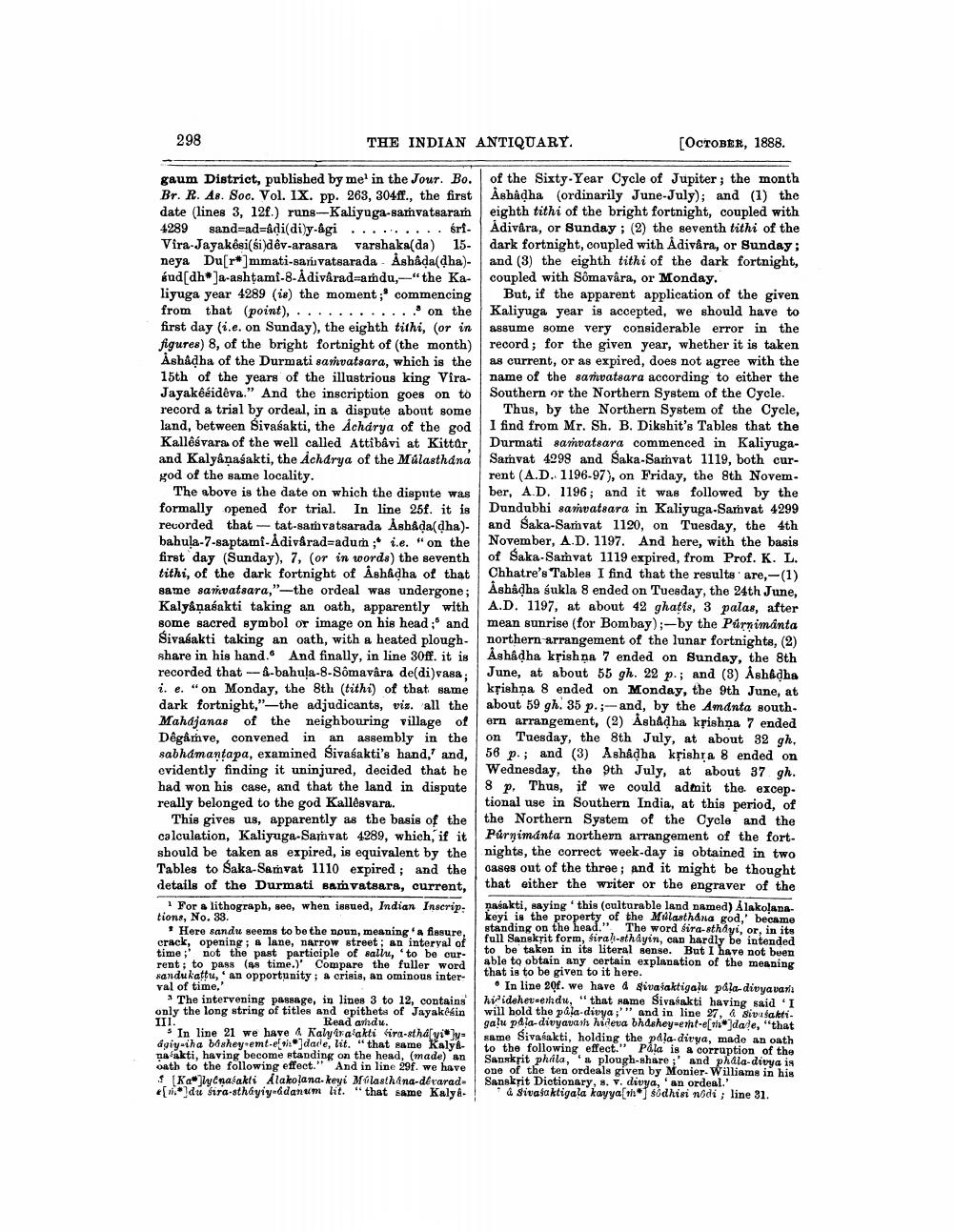________________
298
THE INDIAN ANTIQUARY.
éri
gaum District, published by me' in the Jour. Bo. Br. R. As. Soc. Vol. IX. pp. 263, 304ff., the first date (lines 3, 12f.) runs-Kaliyuga-samvatsaram 4289 sand-ad-adi(di)y-âgi Vira-Jayakêsi(si)dêv-arasara varshaka(da) 15neya Du[r]mmati-sari vatsarada Ashâda(dha)sud[dh*]a-ashṭami-8-Adivârad-amdu,-"the Kaliyuga year 4289 (is) the moment; commencing from that (point), . on the first day (i.e. on Sunday), the eighth tithi, (or in figures) 8, of the bright fortnight of (the month) Ashâḍha of the Durmati samvatsara, which is the 15th of the years of the illustrious king ViraJayakééidêva." And the inscription goes on to record a trial by ordeal, in a dispute about some land, between Sivasakti, the Acharya of the god Kallêsvara of the well called Attibâvi at Kittûr, and Kalyanaśakti, the Acharya of the Mülasthana god of the same locality.
The above is the date on which the dispute was formally opened for trial. In line 25f. it is recorded that tat-samvatsarada Ashaḍa(dha) bahula-7-saptami-Ådivârad-adum; i.e. "on the first day (Sunday), 7, (or in words) the seventh tithi, of the dark fortnight of Ashadha of that same samvatsara," the ordeal was undergone; Kalyaṇasakti taking an oath, apparently with some sacred symbol or image on his head ;" and Sivasakti taking an oath, with a heated ploughshare in his hand. And finally, in line 30ff. it is recorded that--bahula-8-Sômavâra de(di)vasa; i. e. "on Monday, the 8th (tithi) of that same dark fortnight," the adjudicants, viz. all the Mahajanas of the neighbouring village of Dêgâmve, convened in an assembly in the sabhámantapa, examined Sivasakti's hand,' and, evidently finding it uninjured, decided that he had won his case, and that the land in dispute really belonged to the god Kallêsvara.
This gives us, apparently as the basis of the calculation, Kaliyuga-Samvat 4289, which, if it should be taken as expired, is equivalent by the Tables to Saka-Samvat 1110 expired; and the details of the Durmati samvatsara, current,
For a lithograph, see, when issued, Indian Inscrip tions, No. 33.
Here sandu seems to be the noun, meaning 'a fissure, crack, opening; a lane, narrow street; an interval of time; not the past participle of sallu, to be current; to pass (as time.) Compare the fuller word sandukattu, an opportunity; a crisis, an ominous interval of time.'
The intervening passage, in lines 3 to 12, contains only the long string of titles and epithets of Jayakêsin III. Read amdu.
[OCTOBER, 1888.
of the Sixty-Year Cycle of Jupiter; the month Ashadha (ordinarily June-July); and (1) the eighth tithi of the bright fortnight, coupled with Adivâra, or Sunday; (2) the seventh tithi of the dark fortnight, coupled with Adivâra, or Sunday; and (3) the eighth tithi of the dark fortnight, coupled with Sômavâra, or Monday.
But, if the apparent application of the given Kaliyuga year is accepted, we should have to assume some very considerable error in the record; for the given year, whether it is taken as current, or as expired, does not agree with the name of the samvatsara according to either the Southern or the Northern System of the Cycle.
In line 21 we have 4 Kalytraakti ira-stha yiyágiyiha bashey-emt-edade, lit. "that same Kalya na akti, having become standing on the head, (made) an oath to the following effect." And in line 29f. we have Kalynasakti Alakolana-keyi Múlasthina-dévarad[du sira-stháyiy-ádanum lit. that same Kalya
Thus, by the Northern System of the Cycle, I find from Mr. Sh. B. Dikshit's Tables that the Durmati samvatsara commenced in KaliyugaSamvat 4298 and Saka-Samvat 1119, both current (A.D. 1196-97), on Friday, the 8th November, A.D. 1196; and it was followed by the Dundubhi samvatsara in Kaliyuga-Samvat 4299 and Saka-Samvat 1120, on Tuesday, the 4th November, A.D. 1197. And here, with the basis of Saka-Samvat 1119 expired, from Prof. K. L. Chhatre's Tables I find that the results are,-(1) Ashadha śukla 8 ended on Tuesday, the 24th June, A.D. 1197, at about 42 ghatis, 3 palas, after mean sunrise (for Bombay);-by the Purnimanta northern arrangement of the lunar fortnights, (2) Ashadha krishna 7 ended on Sunday, the 8th June, at about 55 gh. 22 p.; and (3) Ashadha krishna 8 ended on Monday, the 9th June, at about 59 gh. 35 p.;-and, by the Amanta southern arrangement, (2) Ashadha krishna 7 ended on Tuesday, the 8th July, at about 32 gh, 56 p.; and (3) Ashadha krishra ended on Wednesday, the 9th July, at about 37 gh. 8 p. Thus, if we could admit the exceptional use in Southern India, at this period, of the Northern System of the Cycle and the Purnimanta northern arrangement of the fortnights, the correct week-day is obtained in two cases out of the three; and it might be thought that either the writer or the engraver of the
nasakti, saying this (culturable land named) Alakolanakeyi is the property of the Millasthana god, became standing on the head." The word sira-sthayi, or, in its full Sanskrit form, sirah-sthayin, can hardly be intended to be taken in its literal sense. But I have not been able to obtain any certain explanation of the meaning that is to be given to it here.
In line 20f. we have 4 Sivasaktigalu pála-divyavari hiideher-endu, "that same Sivasakti having said 'I will hold the pala-divya;'" and in line 27, & sivuśaktigalu pala-divyavash hideva bhdshey-emt-e[m]dale, "that same Sivasakti, holding the påla divya, made an oath to the following effect." Pala is a corruption of the Sanskrit phila, a plough-share; and phala-divya is one of the ten ordeals given by Monier. Williams in his Sanskrit Dictionary, s. v. divya, an ordeal.'
& Sivasaktigala kayyam* sodhisi nodi; line 31.




